Why Scientists are researching on Great Stickiness of Small Creatures
For most people, a gecko is a lizard that rushes on walls and ceilings. Each finger of the gecko is equipped with strips of dense rows of branched keratinous bristles forming a pad (Figure 1). In the classical research object, the gecko Gekko gecko currents about 30 cm long, one cushion is approximately 1 cm. These pads, though sometimes called sticky, do not secrete any glue, the lizard sticks dry, for this it needs to press the presser foot against the surface and lightly move. As a result of sliding, there is a cohesion between the bristles and the surface to which they adhere as a result of van der Waals interactions and friction.
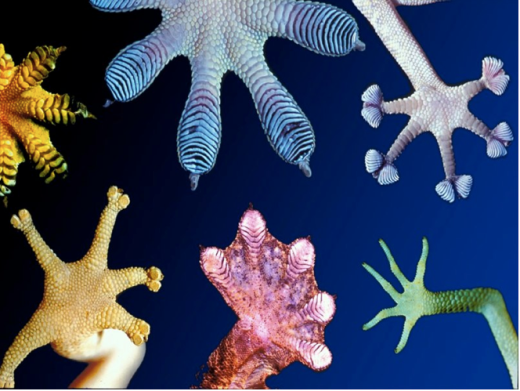
source
The foot of the gecko Gekko gecko, finger with sticky strips and a bunch of bristles
The strength of the adhesion of one bristle is less than a milliliter, but there are millions of them, and together they are able to withstand the weight of twenty geckos. On the basis of the structure of gecko "stickies" have already made all kinds of devices for climbing the walls and hanging on the ceiling and they are working so successfully that the question arises: does the gecko regulate the strength of adhesion, or is it only to rearrange the feet, while the stickiness of the fingers - property of their coverage, "fundamentally passive," as the authors of one article put it. Different scientists noted that in the case of dead geckos, fingers somehow cling to the walls. On the other hand, the adhesion of dead or immobilized lizards, according to some reports, is weaker than that of the living.
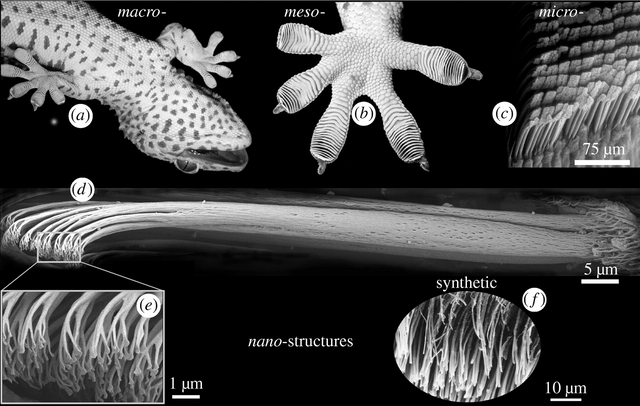
The foot of the gecko Gekko gecko, finger with sticky strips and a bunch of bristles..source
And if the gecko does regulate the force of the clutch, the researchers can not understand how the lizard does it. His contribution to the solution of the problem was made by the associate professor of the University of California Timothy Highem and his postdok William Stewart (Biology Letters, 2014, 10, doi: 10.1098 / rsbl.2014.0701). They compared the adhesion of the paws of the living and dead gecko by means of a specially designed device that allows measuring the forces that arise when the animal is torn from a vertical surface .(Fig. below)
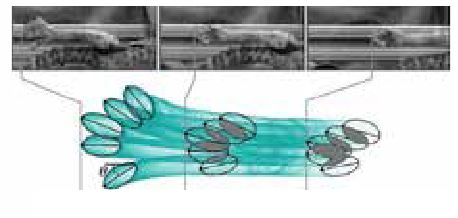
Controllable detachment of a gecko..source
To tell you the truth, the device, which the researchers are very proud of, is reminiscent of a medieval torturing machine, or some ancient construction device. On the leg of the gecko put on the clamp and stick it to the vertical acrylic plate. Then the lizard from this surface is torn off with an ever-increasing force, which creates sand pouring into the container. The strength of the detachment of the gecko was measured by a dynamometer. The position of the paw and the attachment of the fingers were recorded by two video cameras. Using the images obtained, the scientists calculated the force of the adhesion of the foot, proceeding from the fact that the density of the bristles and the force with which each of them clings are known. The lizards were five, each pulled several times with five-minute intervals for rest. Then geckos were killed by injection of euthanazole (31% pentobarbital sodium) directly into the heart. Death came after seven minutes, and for half an hour the researchers pressed the paw of the dead lizard a few times against the acrylic plate and tried to mold it.
The stronger the gecko is stripped of acrylic, the stronger it clings to it. To tear it off, you need to make an effort, 4.4 to 12 times the weight of the lizard. Death, oddly enough, did not affect the strength of adhesion. The researchers were also surprised that the peak force of adhesion, that is, the maximum after which the paw detached from the surface, varies in different experiments, and varies to an equal degree in both the live and the dead. Sometimes this force decreased from an attempt to try, sometimes increased, so there is no reason to think that its changes are caused by lizard fatigue or the time that has passed since death. In some cases, the peak power reaches six Newtons at an average weight of lizards of 46 g.
The living gecko adheres to the surface of all the five fingers and holds until it is removed, the fingers of the dead one by one, which, to the astonishment of the researchers, does not affect the strength of adhesion. The remaining fingers take a load on themselves. Perhaps the fact is that in a gecko, dead or alive, when it is pulled by the paw, the fingers gradually approach each other, the adhesive pads get on each other, the area of their contact with the surface decreases, the adhesion force also (Figure 3). If one of the fingers is unstuck, its pad no longer hits the others and the grip area is not shrinking much.
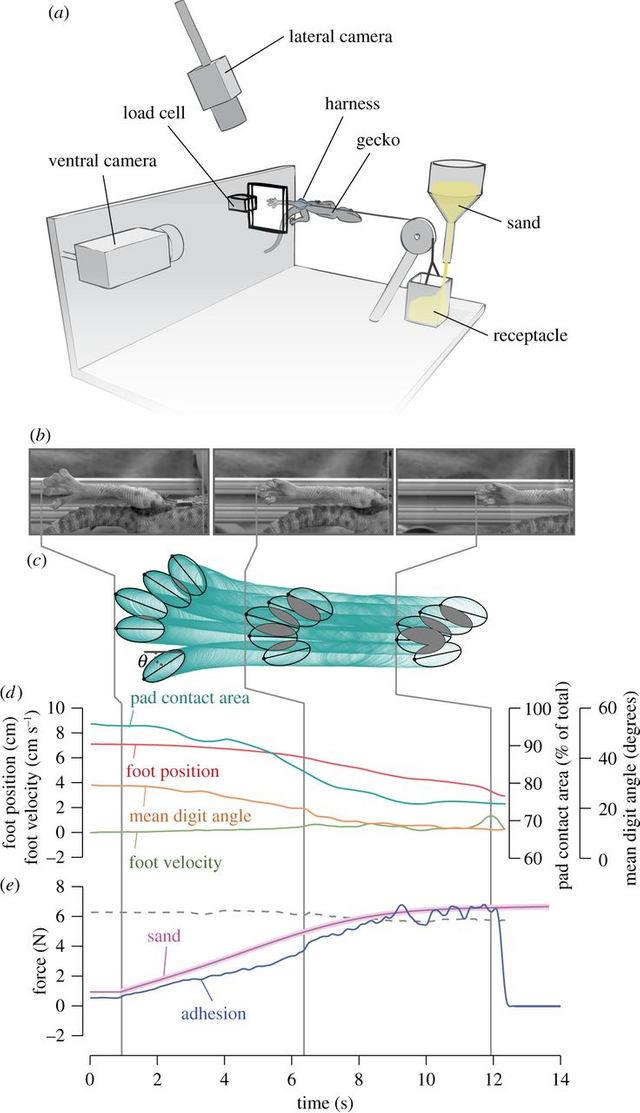
source
Fig.above. When the gecko is pulled by the paw, its fingers approach each other, the pads run into each other and the area of their contact with the surface decreases (from left to right)
From the observations of Californian scientists it follows that death does not affect the force with which the gecko holds onto the surface, the speed of movement of the foot when it is pulled, and the position of the fingers. But somehow the living lizard can still do it. When the tension becomes too great, it sharply spreads out the fingers, even bending them off the surface, and instantly falls apart. And this, according to researchers, is the main mechanism of adhesion regulation, which the gecko has. Perhaps the ability to quickly release the paw developed in addition to the ability to tighten it firmly to the surface, and a combination of these properties allows the gecko to be worn on walls and ceiling.
Arion glue
Engineers are watching animals, not without reason, hoping to borrow from them some useful technical solution, but sometimes it is the other way around: biologists find answers to the questions they are interested in in engineering. For example, now technologists are extremely interested in hydrogels, which are three-dimensional polymer networks in a large amount of water, from 50 to 99%. Hydrogels are widely used in various fields, including as drug delivery systems, superabsorbents, contact lens materials, and recently talked about the fact that they are promising materials for tissue engineering, as they react to movement and resemble cartilage in structure, tendons and muscles. But, alas, hydrogels lack strength, resistance to mechanical influences. Materials scientists have found a way to make the hydrogel elastic and rigid: for this, two networks with different properties are connected in one gel. One is sturdy and tough, and the other is easily deformed, with few stitching. The technology of "hydrogels with two networks", in English double network gels, is actively developed by specialists from several foreign laboratories ("Polymer", 2012, 53,1805-1822, doi: 10.1016 / j.polymer.2012.03.013).
Artificial "double" hydrogels interested in the professor of Ithaca College (USA) Andrew Smith, who, along with his students, studies the transformation of mucus mollusks. These mucus also represent hydrogels, and dilute, 95-97% consisting of water. Liquid mucus is not sticky, it protects land mollusks from drying and provides lubrication during movement, but in some species this friable substance turns into a real superglue. For example, snails with his help are held on damp stones, and to tear them off, they need tools. What turns grease into glue? Andrew Smith suggested that these mucus are gels with a double network, and, apparently, was right ("Journal of Experimental Biology", 2015, doi: 10.1242 / jeb.128991).
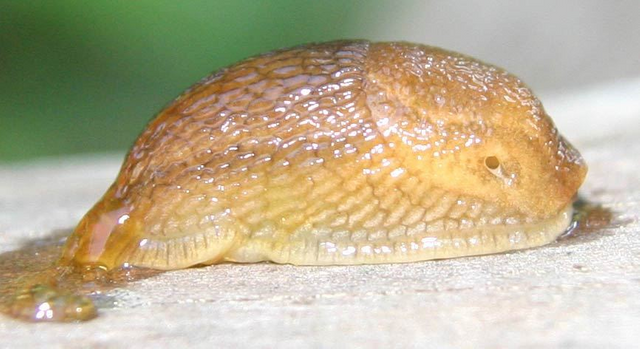
Slug brownish Arion subfuscus secretes a protective gel, which turns into a strong adhesive..source
As an object of research, Professor Smith chose the land brownish slug Arion subfuscus. In case of danger of a gland, an orange gel is isolated on the back, which very quickly solidifies into a rubber-like mass (Fig. above). This protective secret is sticky and hard at the same time. If you glue them with acrylic discs, they stick together in a matter of seconds, and you need an effort of about 100 kPa to separate them. A sample of protective mucus stretches once every ten. To collect material for the study, the slugs were brought to the laboratory, they massaged the backrest slightly to stimulate the secretion of the protective secret, which was carefully scraped with a spatula. One mollusk secretes 40-50 mg of mucus, Andrew Smith compares this amount with a half eraser on a pencil. Samples were frozen for future research, and slugs were returned to the place from which they were taken. Freezing and subsequent thawing did not affect the properties of mucus.
First of all, scientists determined the composition of protective mucus. It contains proteins called asmp (Arion subfuscus mucus protein), these proteins can bind to metals, and most of them are combined into large complexes. Metal ions are also present: zinc, calcium, iron and copper. In addition, the secret of the slug contains sulfated polysaccharides. Each component has its own functions. Metal ions bind to negatively charged large carbohydrate polymers, providing the formation of an elastic polysaccharide network. Iron and copper ions can also catalyze the oxidation reactions of some amino acids, such as lysine; As a result, carbonyl groups are formed that react, forming covalent bonds. So the second network is formed - strong protein. These networks are in contact with each other, since the mucosal polysaccharides of A. subfuscus form bonds with proteins. Conventional protein networks are quite fragile, they are easy to damage. But in order to destroy the glue of the Arion, it is necessary to break the second network, which is much more difficult, since the principle of weak bonds and the hidden length of the molecule works (Fig. below).
The protein network is connected to polysaccharide weak bonds. These bonds pierce the molecules of carbohydrates, and some of their length is as if pinned inside. So sometimes children sew clothing to grow, removing the stock of fabric in the seams. When an effort is applied to the gel, the protein network is rapidly destroyed, weak bonds break, and the polysaccharide network molecules unfold in full length. The volume of the gel thus increases sharply, and the force applied initially to a small sample is "smeared". To destroy such a gel, you need to spend much more energy. The strength of a gel with a double network is several orders of magnitude greater than that of two independent single networks. Andrew Smith treated Arion gel with enzymes that selectively destroy the protein or polysaccharide network. In all cases, the gel completely lost its elasticity and strength and became gummy and watery, like ordinary slime-grease. Thus, each of the networks separately creates a low viscosity, but together they form a strong material.
The researchers note that the mechanism of converting mucus to different molluscs is still to be specified, but they are not idle. They want to find material that can be used as medical glue. Modern medical glues have limited capabilities, they are used only when the incision is clean, with even edges and not too deep. Andrew Smith hopes that the study of gels of snails and slugs will help him get a gel that will withstand the action of bodily fluids and deformation of surfaces and will not leave the scars.

References:
1, 2, 3, and 4
Support @steemstem and the #steemstem
project - curating and supporting quality STEM
related content on Steemit

Good read!
Congratulations @marverick984, this post is the fifth most rewarded post (based on pending payouts) in the last 12 hours written by a Newbie account holder (accounts that hold between 0.01 and 0.1 Mega Vests). The total number of posts by newbie account holders during this period was 4217 and the total pending payments to posts in this category was $4042.35. To see the full list of highest paid posts across all accounts categories, click here.
If you do not wish to receive these messages in future, please reply stop to this comment.
Nice post! There is a whole area in engineering to mimic nature and features of animals to innovate technology for healthcare! We will follow you closely